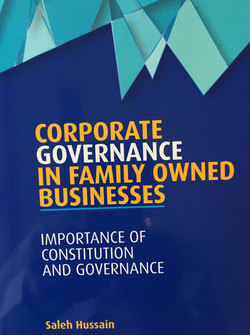Читать книгу Corporate Governance in Family Owned Businesses - Saleh Hussain - Страница 4
На сайте Литреса книга снята с продажи.
Introduction
ОглавлениеFact #1 : Families who work well together often build strong businesses that are hard to compete against.
Fact#2: Families who struggle to work well together simply find it hard to compete.
“Relationship Advantage Inc.”
Family Owned Businesses (“FOBs”) are the very important streamline of blood or oil or both, for the engine of the world economy. They represent no less than 75% of entire world General National Products (“GNP”). The FOBs employ between 35% to 65% of workforce in any one country. The weight they carry entitles them to have undeniable impact on the social and financial dimensions of any economy.
In this book, we look at the importance of FOBs, their contributions to the world economy and the issues they need to address to overcome structural, governance and business issues. Relationships between owners of FOBs and their siblings and relatives, if not clarified, could break the backbone of FOBs and cause some of them to vanish. Most of FOBs vanish when they reach third generation and the most alarming cause is lack of proper governance system.
The FOBs have a common problem. This problem revolves around their inability to segregate and resolve family position from ownership and management. We try in this book to shed light on the challenges facing FOBs and the opportunities open to them to prosper and advance.
The book contains SEVEN chapters. Chapter ONE gives an introduction about family businesses and various definitions of FOBs.
Chapter TWO deals with facts, figures and characteristics of FOBs on worldwide basis, Middle East and GCC. The stated facts and figures in the chapter were derived from respected sources and good number of them represents studies and surveys conducted by professional institutions.
Chapter THREE deals with challenges and opportunities of FOBs and gives SWOT analysis of their businesses.
Chapter FOUR addresses the need for introducing Corporate Governance practices to be embraced by FOBs. Contents of CG practices as detailed, cover important areas such as role of Board of Directors, Board Committees, Succession Planning and internal & external control. In addition, the chapter discusses the need for a robust risk management system and compliance environment. To have a strong CG, you need to have in place number of policies and procedures. These are covered in this chapter as well.
Chapter FIVE explains why a family constitution is important for FOBs. The contents of such document are included. Role of family assembly, advisory board and committees are among many issues covered in the constitution.
Chapter SIX addresses the option for FOBs to go public. It explains the pros and cons of going public and the need to plan for an IPO. Examples of GCC family businesses that went public are given.
In Chapter SEVEN we talk about the role of FOBs and Corporate Social Responsibility. The support of CSR by FOBs has a number of rewards for them. The clarity of appreciation CSR by FOBs makes a win-win situation for the companies and the society.
We hope that contents of this book prove to be useful.
